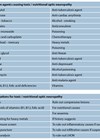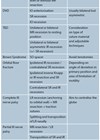Top Tips archive for 2022
Congenital cranial dysinnervation disorders (CCDDs)
The term congenital cranial dysinnervation disorder (CCDD) was introduced by Gutowski et al. in 2003 to describe strabismus conditions that result from developmental error in innervation of some of the extraocular muscles. Examples of these conditions include Duane’s syndrome and...
Toxic nutritional optic neuropathy (TON)
Toxic optic neuropathy are a group of conditions manifested by reduction of visual functions secondary to damage to the anterior visual pathways from exposure to a toxin. The implicated toxin could be work-based, food or drink related, or iatrogenic medication....
Supranuclear ocular motility disorders
Figure 1: Bilateral INO Introduction Complex ocular motility disorders are a diagnostic challenge. These patients come with very complex ocular motility presentations and require a careful and detailed assessment in order to find the correct diagnosis and arrange appropriate investigations....
Surgical strategies to manage incomitant strabismus in adults
Incomitant vertical and / or horizontal strabismus is a challenging presentation. Patients are usually symptomatic as the onset is either sudden so they haven’t developed any coping mechanisms or very complex so that any coping mechanisms will not cover all...
How to nearly (but not quite) get into ST1 ophthalmology training – some reflections
Ophthalmology is often considered to be an elite, highly competitive specialty, with little room for failure. Candidates and trainees tend to cultivate a certain urbane and confident style, and the bottleneck at ST1 can feel rather intense. The majority of...










